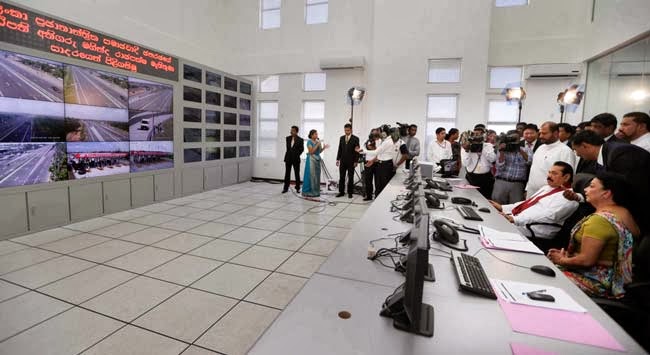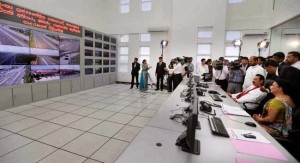Children of a Lesser God by Tisaranee Gunasekara
“…justice by its very nature has to have a universal reach, rather than being applicable to the problems and predicaments of some people but not of others”.
Amartya Sen (The Idea of Justice)
Rs.1.8 billion was spent on building one kilometre of the Katunayake-Colombo expressway.
That was more than the 2014 Budgetary allocation for Child Development and Women’s Affairs (Rs.1.24 billion), Culture and Arts (Rs.1.48 billion), Telecommunication and Industrialisation Technology (Rs.0.957 billion), Wildlife Resources and Conservation (Rs.1.31 billion), National Heritage (Rs.1.26 billion) or Foreign Employment Promotion and Welfare (Rs.0.58 billion).
The total cost of the new expressway was Rs.45.7 billion, reportedly sufficient to purchase 7 tonnes of gold at current market prices2. The money spend on this one short expressway is higher than the 2014 Budgetary allocation for Education (Rs.38.84 billion), Irrigation and Water Resource Management (Rs.41.2 billion), Agriculture (Rs.44.47 billion), Higher Education (Rs.29.5 billion), Power and Energy (Rs.23.74 billion), Technology and Research (Rs.3.76 billion), Environment and Renewable Energy (Rs.4.26 billion) or Social Services (Rs.4.3 billion).
The Southern Expressway is a loss-maker (around Rs.5.5 billion annually, due to debt-service costs3); there is no reason to think that the Katunayake-Colombo Expressway would fare any better. This danger is particularly acute given that the new expressway was built with a Chinese loan and the Chinese seems to be more prone to Shylockian methods than even the Americans or the IMF – as evidenced by the sudden punitive increase (5%) in the interest on the loan for the jobless-Hambantota Port. (The ordinary homes of ordinary people near the new expressway have become structurally compromised. They are yet to receive the promised compensation – and may never will.)
According to Fitch Ratings, post-war Sri Lanka has been remarkably unsuccessful in attracting foreign direct investment (FDI); the average net FDI since 2009 is a miniscule 1.2% of GDP. “This is low in comparison with most regional peers and has fuelled a reliance on debt-creating capital….. This has kept the external debt burden at 57% of GDP which is much higher than all other emerging Asian markets, except Mongolia”4.
Predictably the largest chunk in the 2014 Budget is set aside for Defence and Urban Development. A recent news item indicates the confoundingly illogical manner in which some of this mammoth allocation might be spent. According to the Daily Mirror, post-war Sri Lanka is planning to buy JF-17 Thunder combat plane(s) from Pakistan5. The jets are being manufactured as a Pakistan-Chinese joint venture; the minimum production cost of a plane is estimated at US$ 15 million. Even if Colombo buys only one fighter-jet and does so by paying only the lowest production cost, it would cost the country a behemothic Rs.1.96 billion.
Why does Sri Lanka, which is not menaced by any armed threat internally or externally, need to buy fighter-jets at such a mountainous cost?
China is reportedly keen to find buyers for the JF-17 combat planes – since 2011. So far only the Pakistani Air Force has actually agreed to purchase the jets. Are we buying weapons we do not need, due to Chinese pressure? Have the Chinese adopted the US/Western practice of tied-aid and taken it to still more execrable lengths? Is Mao’s warning about the ‘Sugar-coated bullets’ of the bourgeoisie more applicable to the international economic policies of his successors?
China is the world’s fifth largest exporter of major conventional arms, according to the Stockholm International Peace Research Institute. Tiny Sri Lanka reportedly accounts for 2% of total Chinese arms sales6. Will we have to spend increasing amounts of our national wealth – and incur more Chinese debt – to purchase superfluous pieces of exorbitantly-priced military hardware, as our ‘contribution’ to China’s growing military-industrial complex?
Are the Rajapaksas beggaring the nation and burdening countless future generations with a colossal debt to appease their Chinese patrons and keep the money coming for their megalomanic projects?
Even as national security costs become rooted at stratospheric levels, the security of ordinary people continues to erode. Ordinary Lankans are menaced not just by increasingly violent criminals and increasingly ubiquitous criminal politicos but also by the discriminatory politico-economic-social polices of the Rajapaksas.
In the 1990’s the UNDP warned about false growth paths which can undermine a country’s future: Jobless Growth, Voiceless Growth (growth without participation, empowerment and democracy), Ruthless Growth (growth which widens the rich-poor gap), Rootless Growth (growth which destroys positive cultural traditions) and Futureless Growth (growth which denudes the environment). The Rajapaksa economic strategy seems to be a concourse of many of these false – and anti-developmental – growth paths. The Hambantota Harbour is a classic example for ‘Jobless Growth’ while the incidents of water and air poisoning in Weliweriya, Dorape and Batakettara indicate that people might find their habitats unliveable in the most basic sense, sans breathable air and drinkable water. (Incidentally, such basic environmental degradation can affect the rich and the powerful as well).
The Supreme Court ruling against the residents of Slave Island has opened the door to mass-eviction of people from their homes/communities in the name of development. Emboldened by the UNP’s indifference (a mindset common to Ranil Wickremesinghe and Sajith Premadasa; neither one nor the other has come forward to protect Colombo’s poor who are also UNP supporters/voters) the regime is likely to intensify its land-grabbing. Incidentally, the seven acre prime-land freed from its Lankan inhabitants will be given to the Indian TATA company.
In Kattuwan North, Jaffna, the military has begun demolishing houses to expand army bases. Brigadier Ruwan Wanigasuriya dismissed this dispossession by claiming that it was being done legally: “There could have been legal owners previously. But now the lands have been taken over by the government”7.
From North to South, the Siblings will use the Rajapaksa-judiciary to provide legal cover for acts of pillage by the Rajapaksa-state. And ordinary people, of all ethnicities/religions, will be left with no protection, succour, recourse or rescue.
Discriminatory Governance
Discrimination is a fundamental Rajapaksa trait, a defining characteristic of the Siblings’ political and socio-economic policies. Treating ordinary Lankans (including their own supporters – ex. Weliweriya) as ‘children of a lesser god’ is a basic tenet of Rajapaksa rule.
Adam Smith warned that the “disposition to admire, and almost to worship, the rich and the powerful, and to despise, or, at least, to neglect persons of poor and mean condition…is…the great and most universal cause of the corruption of our moral sentiments.”8 That attitude has become the leitmotiv of Rajapaksa Governance, as is evidenced by sharp contrast between the Siblings’ juvenile excitement about the Commonwealth or their reverential welcome to the likes of James Packer and their total indifference to the socio-economic trials and travails of ordinary Lankans.
An economy can be neo-liberal or state socialist/capitalist; it can be market or state dominated or a combination thereof. But if policymakers do not place human welfare at the centre of development or factor human welfare in crafting and implementing economic strategies/tactics, development will remain an abstraction as far as the majority are concerned.
To use a Biblical parable, it will be the kind of economy where the stealing of the poor man’s sole ewe by the rich man is depicted as development. Isn’t that the Rajapaksa-Way?
1 The title is from an American movie which in turn was inspired by a line in a Tennyson poem, ‘Idylls of the King’.
2http://www.lankabusinessonline.com/news/an-expressway-paved-with-gold/1954913131
3 http://www.ceylontoday.lk/27-28421-news-detail-southern-expressway-incurs-rs-55-b-loss.html
4 http://www.fitchratings.com/gws/en/fitchwire/fitchwirearticle/Sri-Lanka’s-Resilience?pr_id=805953&cm_sp=homepage-_-FitchWire-_-%20Sri%20Lanka’s%20Resilience%20Masks%20Medium-Term%20Credit%20Risks
5 http://www.dailymirror.lk/top-story/37722-pakistan-to-sell-jf-17-fighter-jets-to-sl-report.html
6 http://www.thehindu.com/news/international/world/china-shoots-into-top-arms-exporters-club/article4522762.ece
7 http://www.bbc.co.uk/sinhala/sri_lanka/2013/10/131028_jaffna_houses_land.shtml; http://colombogazette.com/2013/10/29/army-says-land-acquired-legally/
8 The Theory of Moral Sentiments
_ Sri Lanka Guardian

